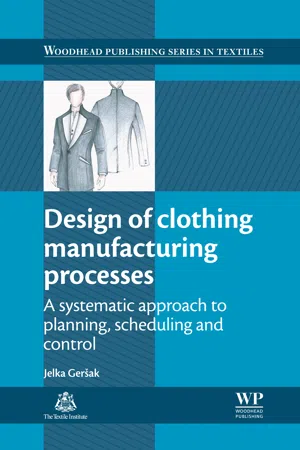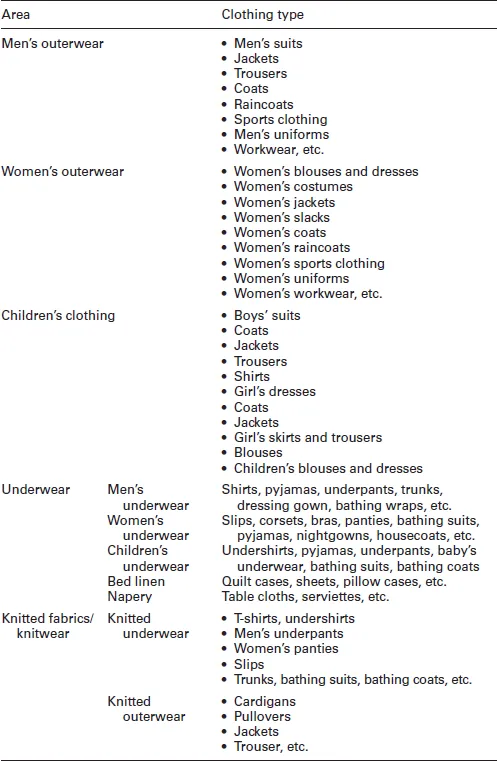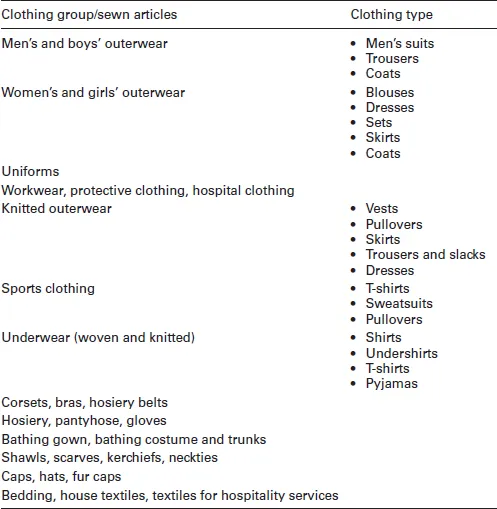
eBook - ePub
Design of Clothing Manufacturing Processes
A Systematic Approach to Planning, Scheduling and Control
- 320 pages
- English
- ePUB (mobile friendly)
- Available on iOS & Android
eBook - ePub
Design of Clothing Manufacturing Processes
A Systematic Approach to Planning, Scheduling and Control
About this book
The era of mass manufacturing of clothing and other textile products is coming to an end; what is emerging is a post-industrial production system that is able to achieve the goal of mass-customised, low volume production, where the conventional borders between product design, production and user are beginning to merge. To continue developing knowledge on how to design better products and services, we need to design better clothing manufacturing processes grounded in science, technology, and management to help the clothing industry to compete more effectively. Design of clothing manufacturing processes reviews key issues in the design of more rapid, integrated and flexible clothing manufacturing processes.The eight chapters of the book provide a detailed coverage of the design of clothing manufacturing processes using a systematic approach to planning, scheduling and control. The book starts with an overview of standardised clothing classification systems and terminologies for individual clothing types. Chapter 2 explores the development of standardised sizing systems. Chapter 3 reviews the key issues in the development of a garment collection. Chapters 4 to 7 discuss particular aspects of clothing production, ranging from planning and organization to monitoring and control. Finally, chapter 8 provides an overview of common quality requirements for clothing textile materials.Design of clothing manufacturing processes is intended for R&D managers, researchers, technologists and designers throughout the clothing industry, as well as academic researchers in the field of clothing design, engineering and other aspects of clothing production.
- Considers in detail the design of sizing and classification systems
- Discusses the planning required in all aspects of clothing production from design and pattern making to manufacture
- Overviews the management of clothing production and material quality requirements
Frequently asked questions
Yes, you can cancel anytime from the Subscription tab in your account settings on the Perlego website. Your subscription will stay active until the end of your current billing period. Learn how to cancel your subscription.
At the moment all of our mobile-responsive ePub books are available to download via the app. Most of our PDFs are also available to download and we're working on making the final remaining ones downloadable now. Learn more here.
Perlego offers two plans: Essential and Complete
- Essential is ideal for learners and professionals who enjoy exploring a wide range of subjects. Access the Essential Library with 800,000+ trusted titles and best-sellers across business, personal growth, and the humanities. Includes unlimited reading time and Standard Read Aloud voice.
- Complete: Perfect for advanced learners and researchers needing full, unrestricted access. Unlock 1.4M+ books across hundreds of subjects, including academic and specialized titles. The Complete Plan also includes advanced features like Premium Read Aloud and Research Assistant.
We are an online textbook subscription service, where you can get access to an entire online library for less than the price of a single book per month. With over 1 million books across 1000+ topics, we’ve got you covered! Learn more here.
Look out for the read-aloud symbol on your next book to see if you can listen to it. The read-aloud tool reads text aloud for you, highlighting the text as it is being read. You can pause it, speed it up and slow it down. Learn more here.
Yes! You can use the Perlego app on both iOS or Android devices to read anytime, anywhere — even offline. Perfect for commutes or when you’re on the go.
Please note we cannot support devices running on iOS 13 and Android 7 or earlier. Learn more about using the app.
Please note we cannot support devices running on iOS 13 and Android 7 or earlier. Learn more about using the app.
Yes, you can access Design of Clothing Manufacturing Processes by Jelka Geršak in PDF and/or ePUB format, as well as other popular books in Technology & Engineering & Industrial Engineering. We have over one million books available in our catalogue for you to explore.
Information
1
Clothing classification systems
Abstract:
This chapter gives a general overview of clothing classification systems. The first part includes a general classification of clothing and a harmonised customs-based classification system. The second part presents a functionality-based classification which covers the logical types of functional clothing. The chapter includes both classifications and significant terminologies for individual clothing types.
Key words
clothing
classification
functional clothing
protective clothing
medical clothing
sportswear
clothing terminology
1.1 Introduction
Clothing appears to be basic to civilisation (Hollander, 1993). It is a term referring to a covering that is worn to cover the body or to keep warm. It is exclusively a human characteristic, and is a feature of nearly all human societies. The kind and type of clothing worn depends on functional considerations (such as the need for warmth or protection from the elements) and social considerations. The functionality required may differ greatly, depending on its end-uses. Functions include:
• everyday seasonal clothing,
• clothing for protection against extreme environmental conditions,
• sportswear,
• protective clothing for specialist functions (e.g. flame-resistant clothing for firefighters, military clothing),
• medical clothing and allied products.
Clothing may be divided into many types displaying different styles and features. There is no set standard for their classification. Different classifications give rise to different names for clothing. This chapter gives an overview of classification systems as well as commonly used terminologies for individual clothing types.
1.2 General clothing classification
Clothing and related products include all items of clothing and accessories worn by men, women and children of all ages, with the exception of hosiery (stockings, socks and tights) and overgarments such as galoshes (waterproof shoes worn over conventional shoes), umbrellas, etc. From the point of view of many clothing manufacturers, there are five basic areas within clothing production:
• men’s outerwear,
• women’s outerwear,
• children’s clothing,
• underwear,
• knitted clothing.
Table 1.1 shows the types of clothing as they relate to areas of production.
Table 1.1
Areas of clothing production

Different countries have their own approaches. As an example, the Committee for the Preparation of Acts and Regulations at the Slovenian Ministry of the Economy divides textile and leather products into four groups (SCC, 2005):
• group A – yarns and threads,
• group B – fabrics,
• group C – clothing,
• group D – other textile and leather products.
Articles of clothing (Group C according to the above classification), are divided into seven sub-groups. These are:
• leather garments,
• outerwear, underwear,
• sports clothing,
• workwear,
• protective clothing,
• other clothing,
• clothing accessories.
The division of articles of clothing by subgroups is shown in Table 1.2 (SCC, 2005).
Table 1.2
Article of clothing classification

In addition to the above classification, there is also a general classification of clothing and sewn articles which includes groups of men’s and boys’ clothing, and women’s and girls’ clothing. These groups are further subdivided into:
• outerwear,
• uniforms,
• workwear,
• knitted outerwear,
• sports clothing,
• underwear,
• other clothing and clothing accessories, as shown in Table 1.3 (Anon., 1989).
Table 1.3
General classification of articles of clothing

1.3 Harmonised clothing classification systems
In addition to general classification systems for clothing, most developed and developing countries have now adopted harmonised classification systems to facilitate trade and customs tariffs. The USA has adopted a ten-digit code known as the ‘HTS code’. This is based on a Harmonised System annotated for the purpose of statistical reporting (USITC, 2012). The UK has also adopted a ten-digit code known as the ‘UK Tariff’, or the Customs Handling of Import and Export Freight (CHIEF) system (HMRC, 2012). The European Economic Community (EEC) has adopted an eight-digit code known as ‘TARIC’, which is also based on the Harmonised System. The legal basis of TARIC is Council Regulation (EEC) No 2658/87 on the tariff and statistical nomenclature, and on the Common Customs Tariff (Anon., 1987), as amended. The purpose of this regulation is to establish aCombined Nomenclature which me...
Table of contents
- Cover image
- Title page
- Table of Contents
- Copyright
- Woodhead Publishing Series in Textiles
- Preface
- Chapter 1: Clothing classification systems
- Chapter 2: Clothing sizing systems
- Chapter 3: Key issues in developing a garment collection
- Chapter 4: Planning and organisation of clothing production
- Chapter 5: Planning of clothing design, pattern making and cutting
- Chapter 6: Planning clothing manufacturing
- Chapter 7: Clothing production management
- Chapter 8: Quality requirements for clothing materials
- Index